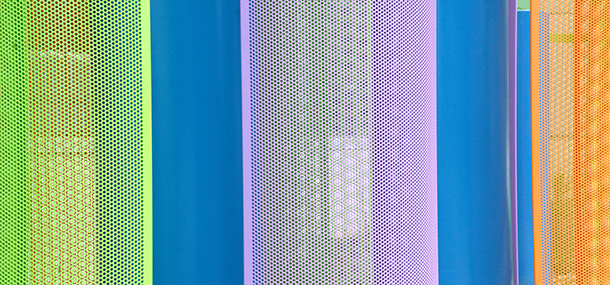
The new research building at Cincinnati Children’s has plenty to offer, not the least of which is an impressive collection of artwork and architectural features. One of the most visible pieces is the multi-colored sculpture entitled Color Field Sculpture by Shelley Parriott outside the building on Albert Sabin Way. Many people walk by it everyday, but few know that it has a secret identity and purpose.
The secret begins below ground on the first floor of the T building. On the other side of the foundation wall are two large rooms designed to accommodate state-of-the-art magnets for Magnetic Resonance Imaging (MRI) systems. The first of these magnets is already installed and operational. These magnets are the secret behind the size, shape and location of the sculpture!
To make a magnetic field useful for MRI, you need a lot of electrical current and many turns of wire. The only practical way to do this is to use superconducting wire, which must be kept very cold. To achieve the ultra-low temperature needed for superconductivity, the magnet windings are submerged in liquid helium, which has a boiling temperature only 4.2 degrees Celsius above absolute zero!
The magnet in the T building needs about 2000 liters of liquid helium to operate. As long as the magnet wire is kept cold, the magnetic field will be maintained. If even a small portion of the wire warms up, however, that segment of wire will no longer be superconducting, and the electrical current in the magnet will be converted into heat, which will quickly cause the surrounding liquid helium to boil away. Since each liter of liquid helium will produce about 700 liters of helium gas, the magnet has to have a way to quickly and safely vent this gas. In other MRI systems, this gas is vented though a large exhaust pipe in the top or side of the building, but in the T building it is vented though art.
At the core of the Sabin Way sculpture is a pair of exhaust pipes for the imaging magnets in the T-building. Since helium venting is a rare occurrence in the lifetime of a magnet, the true purpose of the pipes will be hidden in plain sight for a long time. Someday, however, the magnet may suddenly boil off its helium, and the work of art will then put on quite a performance. Thousands of liters of cold helium gas will rush out of the top of the vent pipe and form huge clouds that will rise skyward. If it is a humid day, a layer of ice may form on the upper portions of the pipe. While it will be a dramatic event, and might even be disconcerting to those walking along Albert Sabin Way, the design of the vent system will keep the magnet, the sculpture, and the people around it safe from harm.
Although there are about 30,000 MRI systems in the world, this is the first that we know of that combines art and function in its vent pipes.
Contributed by Charles Dumoulin, PhD, IRC Director, Professor of Radiology and edited by Tony Dandino (RT-MR).